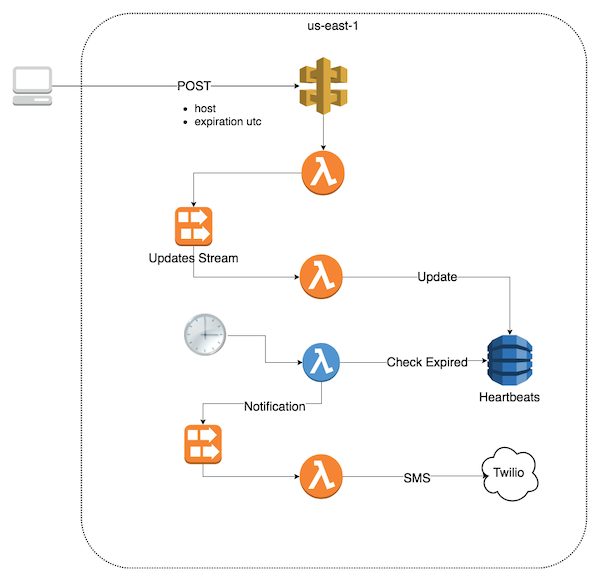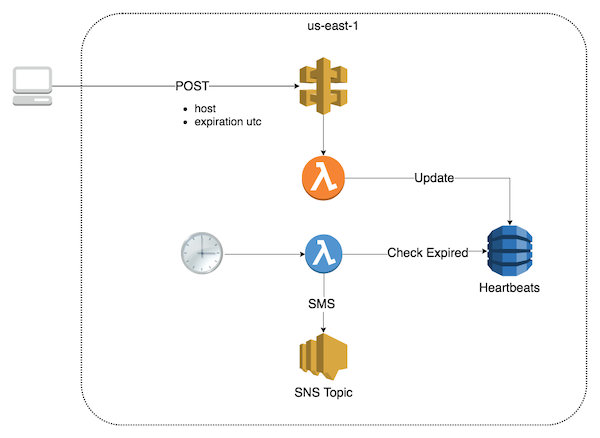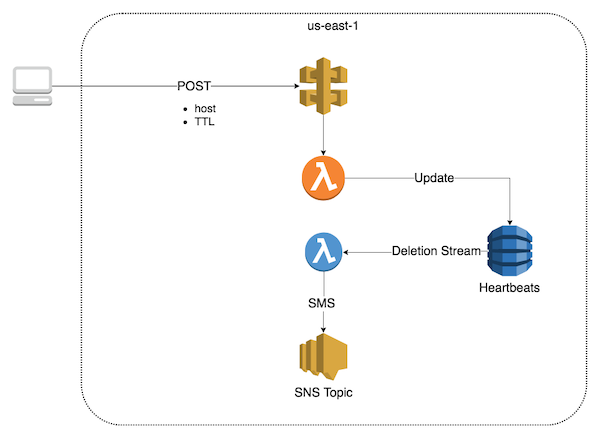# Serverless API Part 1: From idea to Production
Nov 5, 2018 3 minute readI implemented a Heartbeat API to detect when any of my servers crash. I had two requirements. Cheap to operate. And disaster tolerance. Serverless technologies are designed to solve these kind of problems. Here are some lessons learned on my first AWS Lambda hands-on experiences.
This other post explains the Heartbeat Pattern in depth and the need for it. The project sources are available on GitHub.
The Ivory Tower Architect
With very little hands-on knowledge I set my product vision. A highly-scalable distributed system running on standard technologies. I decided the API should be serverless. The technology costs start very low and are driven by usage. AWS is the most mature serverless provider. And Java is a widely supported language.
This would be my first serverless project so I would keep it “simple” [grin].
After some “architecting”1 I ended up with this design.
- Single Region. AWS has very good availability and regional outages are rare. A future release could support multiple regions.
- Two Kinesis streams. One to store messages as they came. Another stream for the notifications.
- One DynamoDB table.
- Multiple lambdas. For authentication, data persistence and analysis.

Why so complicated?
In a word: Ignorance
This initial design had too many redundant components. The project did not need to handle huge loads. Moreover, the minimum operational cost was going to be high.
DynamoDB All the Things. I researched pricing of the different AWS services. Kinesis Streams cost “as little as $0.015 per hour”. Almost $11/mo per region. So that had to go away. DynamoDB would have to solve all the storage needs. This was also my first DynamoDB project. I captured my thoughts on DynamoDB in a separate post.
Api Gateway to the Rescue. I thought I needed a lambda function for authentication and rate limiting. But Api Gateway has all that functionality built-in. One less thing to worry about.
Twilio has a nice API to send SMS. But SNS is also very easy to use. Besides, I would not have to manage a separate set of credentials.
The Serverless Framework and the serverless-dynamodb-local plugin proved to be great resources. They allow local testing, automated deployments, and infrastructure provisioning with code.
The MVP Architecture
As I started building the application I settled on the following design.
- One lambda to save messages.
- Another lambda to scan the table for expired hosts and send notifications.
Two functions. With built-in rate limiting, authentication, decent availability, and scalability.

BONUS: It is always the Database
Since a table scan on the DynamoDB table could have disastrous consequences. I decided to use DynamoDB’s TTL and Streams to reduce the database load. DynamoDB would expire messages automatically. Any database change would trigger a lambda. Such lambda would send notifications for deletions. This design used even less computing resources. It solved the Heartbeat Pattern problem leveraging serverless technologies to its maximum.

Summary
Building serverless applications was easier than I thought. The AWS toolbox is very rich. And the Serverless Framework a great help. With very little code I was able to build a secure, easy-to-use, fault-tolerant, scalable, and cheap, service. Yet, the serverless model is a paradigm shift. Traditional operations may no longer be possible. Eventual consistency and fault-tolerance become the new standard. Thus, hands-on experience is highly valuable. Stay tuned for Part 2 to make the application tolerant to regional outages. And share the operational costs.
-
The Clean Architecture book provides a better approach to architecture ↩